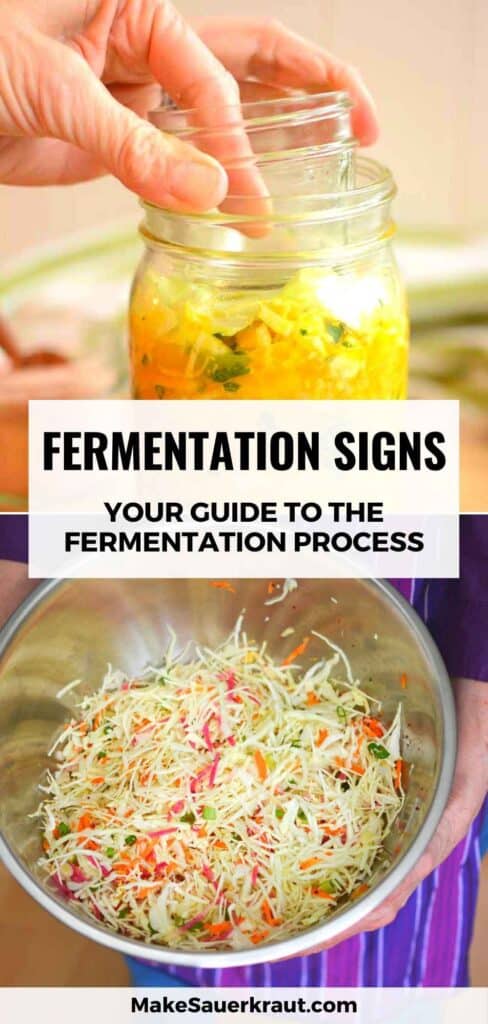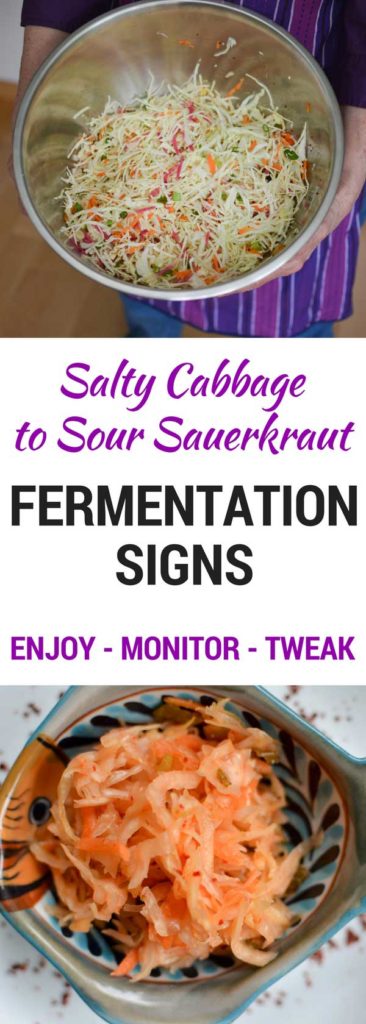You have just packed your jar – or crock – with salted cabbage. It’s sitting on your counter. Now what? Are there fermentation signs to look for?
So many questions.
If I open the jar to sample it, won’t that let in air and then mold will grow?
If I don’t see any bubbles, doesn’t that mean fermentation didn’t happen?
If it smells like bleach, should it be tossed?
Let me hold your hand through the process sharing fermentation signs, letting you know what to watch for and describing how a finished batch of sauerkraut should taste.
The friendly bacteria will be doing most of the work. Your job is to provide the right home for them.
Trust in the process. The wonderful Mighty Microbes really do know what to do.
The hardest part? Waiting seven days to first taste the transformation from salty cabbage to the tangy crunch of sauerkraut.
- Set the Stage for Successful Fermentation
- Label Your Artwork
- Place Your Jar of Fermenting Sauerkraut in a Shallow Bowl
- Find a Spot within the Ideal Temperature Range for Fermentation
- Keep Your Fermenting Sauerkraut Out of Direct Sunlight
- Adjust Fermentation Length to Fermentation Temperature
- Make Sure Your Sauerkraut Mixture is Under the Brine
- Tips to Maximize Probiotic Count
- What to Do While the Mighty Microbes are Working for You
- Evaluate Your Sauerkraut to See If It Has Fermented to Your Liking
- Store Your Sauerkraut
Set the Stage for Successful Fermentation
Your jar is now packed with fresh salted cabbage.
The lid is on.
Fermentation has already started.
What now?
Label Your Artwork
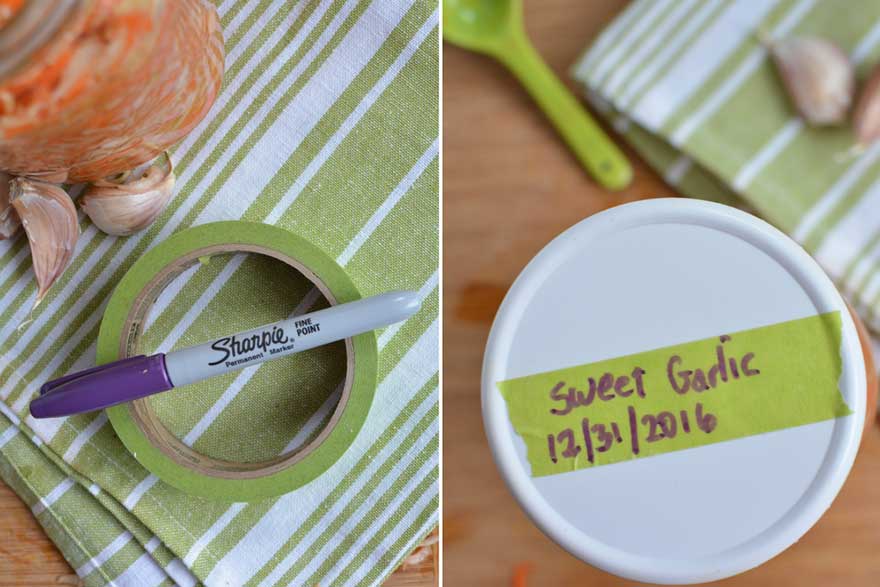
I like to label my jars using green or blue painter’s tape and a permanent marker. I like the “Painter’s Tape” because I can remove it later without leaving a sticky residue. Grab what you have and get marking. I note the flavor of sauerkraut I made and the date I started fermenting it. Believe me, a few weeks into the process, or months later, when you unearth the jar in your refrigerator, you’ll appreciate knowing what’s in the jar and when you made it.
And, it doesn’t hurt to make a few notes on anything specific you did for this particular batch. Some keep this in a separate notebook. Some just add more tape to the jar with extra notes.
Place Your Jar of Fermenting Sauerkraut in a Shallow Bowl
Imagine entering your kitchen. It is one day into the fermentation process. You see brine oozing across your counter and dripping onto the floor…
Why did that happen?
The first set of Mighty Microbes to go to work for you are the gas-producing Leuconostoc Mesenteroides. These bacteria do most of their work during the first 3-5 days, producing acids, alcohols and…
carbon dioxide (CO2), hence the bubbles you see rising to the surface.
However, the CO2 can get trapped within your packed sauerkraut, causing your fermenting mixture to move up in your jar, forcing precious brine to overflow, which is why you’ll want to place your jar of sauerkraut in a dish in order to prevent this brine making a mess on your counter. I’ll cover how to minimize brine overflow below.
Find a Spot within the Ideal Temperature Range for Fermentation
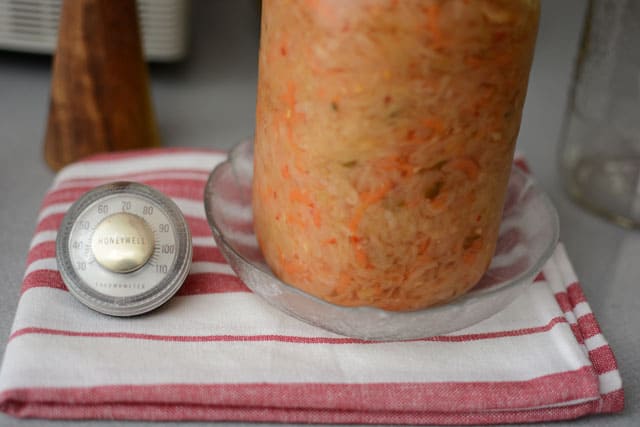
The ideal fermentation temperature range for producing sauerkraut with the most complex flavors is between 65 and 72°F (18–22°C). Fermenting within this temperature range allows the three bacteria strains necessary for fermentation to ferment your cabbage in the proper sequence. For example, the L. Mesenteroides mentioned above might not grow at temperatures higher than 72°F (22°C), which would be detrimental to the flavor of your sauerkraut.
Where your ambient room temperate is within this range will determine the rate at which fermentation happens. The lower the temperature, the slower the fermentation. The higher the temperature, the faster the fermentation unfolds. Ideally, you want the temperature to be somewhat stable, not fluctuating more than 5°F (3°C) in either direction.
It doesn’t hurt to place a thermometer next to your jar to monitor what the temperature is that you’re fermenting at. Nothing to get overly concerned about, but helpful to know if your fermentation is not progressing as expected. The temperature you are fermenting at will help you decide how long to ferment. Some even use a min-max thermometer. It keeps track of what the highest and lowest temperature has been until you reset it. Quite handy.
It’s best to find a spot away from your stove or your refrigerator due to excess heat these appliances might generate.
Temperatures below 60°F (15-16°C) results in a slow and incomplete fermentation.
Temperatures above 80-85°F (27-29°C) can result in abnormal fermentation. Though not ideal, many do successfully ferment in hot weather. You’ll definitely want to shorten fermentation time and to achieve complex flavors in your sauerkraut, find a way to cool things down: 11 Cool Fermentation Tips for Hot Weather.
Keep Your Fermenting Sauerkraut Out of Direct Sunlight
I like to be able to keep an eye on my ferments. There is so much to watch and learn from which is why fermenting in a glass jar is so practical. I keep all my ferments in my kitchen on the counter and out of direct sunlight, but still illuminated by indirect light.
The high levels of ultraviolet radiation in direct sunlight can destroy or inhibit the bacteria that will be working for us and can also diminish nutrients in the food that is being fermented. So, find a spot out of direct sunlight. If you are concerned about any light destroying the bacteria, feel free to cover your jar with a towel.
Some like to keep their ferments in kitchen cupboards. There is nothing wrong with this, just don’t forget them there in their little dark home, an easy thing to do.
Adjust Fermentation Length to Fermentation Temperature

If your home environment is within the ideal temperature range of 65 to 72°F (18–22°C), 3-4 weeks is a good length of time to ferment your sauerkraut. This allows time for each of the three successive colonizations of hard-working bacteria involved in fermentation to perform their magic.
If your climate is exceptionally warm, the bacteria will progress through these stages much more rapidly and you may find 10 days to be plenty; taste at about Day 5. If your house is extra cool, it may take 4-6 weeks for your sauerkraut to fully develop; taste around Day 10.
Ideally, you are not opening your jar numerous times and disturbing the friendly, hard-working bacteria. However, it’s a learning process and tasting is a good way to learn. And it’s nice to know that by Day 7, the L Mesenteroides have typically produced enough lactic acid to protect it from outside invaders they may try to sneak in when opening your jar.
I further discuss adjusting the length of fermentation to your home environment and your taste buds below.
Make Sure Your Sauerkraut Mixture is Under the Brine
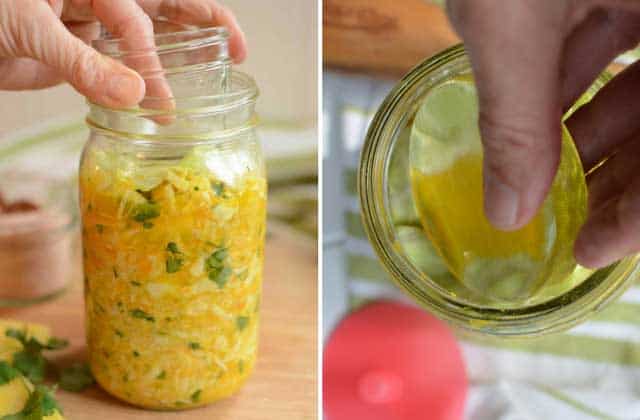
The fermentation of sauerkraut is an anaerobic process. This means your mixture of sauerkraut needs to remain below the brine by using a fermentation weight of some sort. Even if you are using a lid with some type of airlock, your fermenting sauerkraut mixture still needs to be below the brine.
Most books and articles on fermentation – including myself – are quick to have you mix up additional brine and pour this into your jar of packed sauerkraut if there is not enough brine to cover it. A year or so ago, I found in my favorite fermentation book, Fermented Vegetables – reviewed here, that authors Kirsten and Christopher Shockey recommend against adding brine claiming doing so results in discoloration and mushy sauerkraut. This has been tickling my brain ever since and I’m slowly finding that adding fresh – or fermented brine – does negatively impact texture and flavor.
So, if you just packed your jar – or it’s only been 12-24 hours – and your sauerkraut is not under some brine – even a rather thin layer, see my suggestions in Dry Sauerkraut? 17 Transformative Tips [BONUS: Gut Shots Recipe] for ways to get more liquid into your jar.
NOTE: Tips #15 and #16 suggest adding brine during fermentation as a last resort. And, in Tip #17, I suggest adding fermented brine before storing your sauerkraut. The jury is not out yet, but I just started eating one of the jars I did that to last winter. I was not all happy with the results: mushy texture, watered-down flavors. Not what I was expecting.
Tips to Maximize Probiotic Count
I don’t quite know where to put this, but I periodically am asked if there is a way to achieve maximum probiotic counts in a ferment. Without expensive lab tests by curious micro-biologists, we don’t know how what we do impacts actual numbers, but to maximize the working conditions for our Mighty Microbes, I suggest the following:
- Use high-quality ingredients. The greater the nutrition of the cabbage and vegetables used, the greater the level of nutrients for the bacteria that will be turning your salty cabbage into sour sauerkraut. This would also include your salt. A mineral-rich salt (Himalayan Pink or Redmond Real Salt) will contain more food for those Mighty Microbes than a processed salt-containing only sodium chloride.
- Use fresh “winter” cabbage. Winter cabbages are planted in late summer and harvested in early fall, ideally after the first frost. These prized cabbages have tight heads, are harder, have thicker leaves and higher moisture content than summer cabbages. You’re in luck if you, or a local farmer, can grow a variety of late cabbage especially suited for sauerkraut making (Krautman, Danish Ballhead, and Premium Late Dutch). In addition, make your sauerkraut before the cabbage has been stored for months.
- Thinly slice cabbage. Cabbage sliced at 1/8th of an inch (2 mm) not only opens more cabbage cells but allows you to pack more cabbage into a jar dispersing more air. How to Slice Cabbage [Which is the BEST for Perfect Sauerkraut?]
- Add the proper amount of salt. Most literature puts this at 2.0-2.5% salt in relation to the weight of the sliced cabbage mixture, though I – and other artisanal fermentation companies – are getting consistent results with a 1.5% salinity. Below 1.5% will result in spoilage. My recipes are set up for a 2.0% salinity. See Salt by Weight for Delicious Sauerkraut… Batch after Batch for help adjusting these numbers.
- Keep your fermenting sauerkraut below the brine. This ensures that the pathogenic bacteria that love fresh air – and can ruin your sauerkraut – do not take up residence in your jar of goodness. In addition, the brine provides a moist environment for the bacteria. Bacteria are like sponges. They don’t pick up nutrients from dry cabbage but will absorb nutrients from the brine and the wet cabbage. Fermentation Weights: Keep Your Ferment Below the Brine
- Use a lid with an airlock (or crock with a water-sealed lid). Yeast and molds need oxygen to survive. The less air you provide them the better. 9 TOP Fermentation Lids for Mason Jar Fermentation [HOW AIRLOCKS WORK]
- Ferment within the ideal temperature range of 65 and 72°F (18–22°C). This may mean waiting until cooler weather to ferment or creating a cooler environment. 11 Cool Fermentation Tips for Hot Weather
- Ferment in a 5-liter (or larger) water-sealed ceramic crock. The larger container and thicker walls create a more stable environment and results in consistently high-quality sauerkraut. Fermentation Crocks: The Who, What, Where, When, Why and How
- Ferment seasonally. Before refrigeration, this is how the harvest was preserved for enjoyment during the cold, winter months. This necessitates a way to store a year’s supply of sauerkraut – that is, a second refrigerator! 5 Ways to Store Fermented Sauerkraut [One is Controversial]
Five years into my sauerkraut making journey, not only did I have a second refrigerator – and a garage to house it, but I also had access to “winter” cabbage and for the past ten years have been making a year’s supply of sauerkraut each fall. Game changer!
What to Do While the Mighty Microbes are Working for You
Once your jar of sauerkraut is safely packed and sitting in the right spot, your work is nearly done. Prepare yourself now for a long watch-and-wait period while our wonderful world of microscopic friends goes to work for you. You may be a bit nervous just leaving that jar alone on its own. Trust. It will not putrefy and turn to poison.
Here are a few tasks and tidbits to help you through the weeks ahead.
Catch Any Overflowing Brine
Your jar should be sitting in a small dish to catch the brine that typically overflows in the first few days. Check your dish daily during the first week. Empty and toss brine as need be.
Ideally, you do not want to lose this precious brine. It helps to keep your ferment anaerobic and provides moisture in your jar of finished sauerkraut. Brine overflow is caused by:
- Air bubbles trapped in your sauerkraut mixture.
- Jar packed too full. You’ll want to get into the habit of leaving 1-2 inches (3-5 cm) of space between the top of your packed sauerkraut and the top of your jar. This gives a place for the brine to go as your packed sauerkraut expands.
- An unusually active batch. This is generally due to extra-high sugar levels in your ingredients and is more common if your sauerkraut includes shredded beets or other extra sweet ingredients.
Clean Airlock
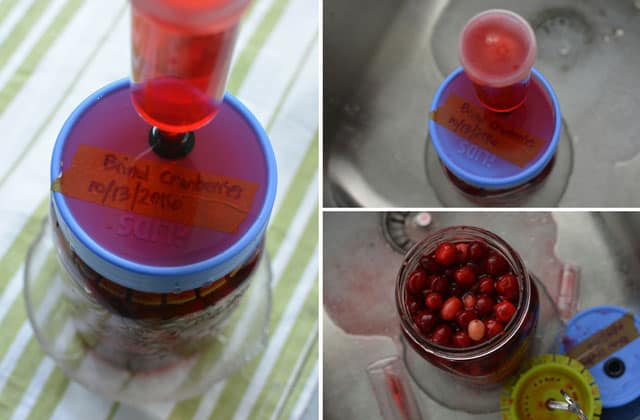
If you are using an airlock, brine can flow up into the chambers. If this happens, wait until the bacteria at the early stages has finished creating the high levels of CO2 that cause the brine to move up – around Day 5 – then pop off the airlock, wash well and replace. If, however, small bits have somehow found their way into the airlock and it looks clogged, go ahead and take care of that right away.
Make Sure Gases are Escaping
If you are using a lid with some type of airlock, gases will escape as need be without any intervention by you.
If you are using the white plastic lid I recommend, or some other lid without an airlock, you may notice that the lid is bulging. This means you screwed it on too tight. To release the trapped gases, carefully loosen the lid just a tad, stopping the second you hear gases escaping or see liquid seeping.
Ignore? or Nab? those Floaty Bits
You should have placed a Floaties Trap – a cabbage leaf cut to size – on top of your packed sauerkraut, and below your weight. Most bits are held under the brine by this, but a few small bits might still manage to escape.
I generally leave them be though by being exposed to air, mold and yeast can grow on them. If you are overly concerned, go ahead and open your jar and fish them out.
Watch for Fermentation Signs
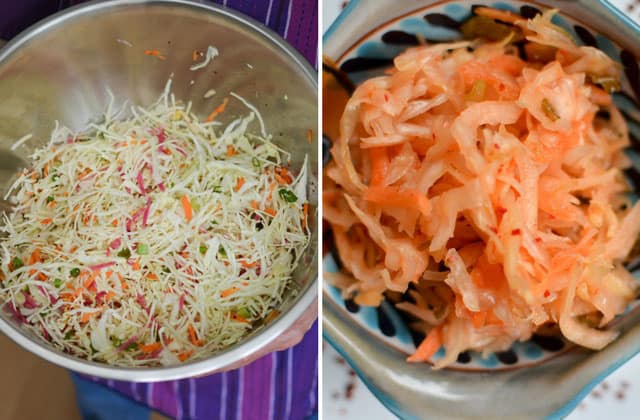
These are the typical changes that your ferment will go through as if transforms from salty cabbage into flavorful sauerkraut.
Tiny Bubbles
Within a day or two, you should see little champagne-like bubbles slowly moving through the sauerkraut and rising to the surface. With some batches (usually those exceptionally high in natural sugars), you may even see a foam-like mass of bubbles collecting on the surface.
These bubbles are most predominate during the initial few days when the first bacterial strain to go to work (L. Mesenteroides) are eating the sugars in your cabbage and vegetables. This produces carbon dioxide, hence the bubbles. Their work also increases the acidity of the brine. When the acidity reaches 0.25 to 0.3% (calculated as lactic acid), the L. Mesenteroides die off – around Day 5 – and the bubbling slows down.
You may also hear an occasional fizzy sound as the bubbles work their way out of your jar.
The amount of bubbles you see depends somewhat on the sugar levels in your cabbage, which can vary quite a bit depending upon variety and growing conditions. Nutritional data shows that the sugar content in 5 types of raw cabbage ranged from 1.18 gram to 3.83 grams per 100 grams.
Though this is one of the key fermentation signs, don’t panic and toss your jar if you don’t see bubbles. They can be elusive and not every batch of sauerkraut progresses through each stage with perfect timing. You are not fermenting in a climate-controlled laboratory!
To reassure yourself that fermentation is progressing, try a few solid taps on the outside of the jar. You should see some bubbles begin to move up the sides of your jar. If not, and if your home is especially cool, you might need to move your jar to a warmer spot.
Cloudy Brine, White Specks and Color Changes
The brine in your sauerkraut may slowly change from clear to cloudy and you may notice some white sediment forming at the bottom of the jar. This white powder is from bacteria and is perfectly normal. If your sauerkraut contains beets, turmeric, or other deeply colored vegetables, you may see the brine change to match the color of what you are fermenting. You may also notice dirty specks of color – especially when using carrots or beets – forming at the top of your jar.
The cabbage and vegetables in your sauerkraut will lose their brightness and the cabbage will become somewhat translucent.
Strong Odors
Old gym socks? Rotten eggs? Sulfur? Even bleach!
Yes, the smell is one of the fermentation signs to “look” for.
Those are just a few of the terms used to describe what fermenting sauerkraut smells like. The sulfur-containing compounds in cabbage – and other cruciferous vegetables – are what produce these strong and pungent odors. Just remind yourself the numerous nutritional benefits they are packed with as your nose adjusts to the odors. Sadly, many a spouse has banished fermentation from the home due to the smells of fermentation.
For some, however, they are not sure if the smell indicates all is well in their jar and they worry that their fermenting sauerkraut is turning to poison. It isn’t!.
But, if you are totally new to sauerkraut and not sure how it should smell, buy a jar of sauerkraut to get a sense of what sauerkraut smells like. Look for raw, unpasteurized sauerkraut in the refrigerated section of a natural foods store. Compare its smell to what you have fermenting and nibble on it while you wait for your sauerkraut to ferment.
If, however, your sauerkraut smells like rotting or putrid food, you’ll want to toss it. Try to figure out what went wrong and then try another batch.
Browning?
If you are fermenting during hot weather, or if your brine levels dropped to expose your top layer of sauerkraut, you may notice that the top layer of your sauerkraut has turned brown. This is from oxidation and this section will have reduced levels of Vitamin C.
The general recommendation is to toss this oxidized layer when you get ready to eat your sauerkraut. Those who hate to waste can just mix the oxidized layer in with the rest of the sauerkraut.
You may also notice browning when using beets in your sauerkraut recipe. This is the color leaching out of the beets, usually if they’re old and are no cause for concern.
You may also notice the brine turning brown. This is usually due to fermenting in warm weather.
Monitor Brine Levels
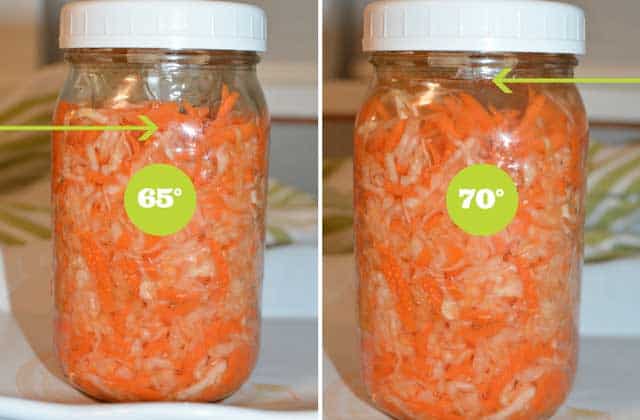
Brine movement by temperatures. For most of the first week, you’ll notice plenty of brine and your packed sauerkraut should remain under this brine. However, you may observe that the level of the brine moves up and down throughout the day. In fact, I find it rather fun to monitor the temperatures in my home by the brine level in my jar of fermenting sauerkraut. Our house tends to be cooler at night and warmer during the day. When I first check on my jar in the morning, I might find the brine level is below the top surface of my ferment. Then, as the house warms up, the brine level rises to almost the top of the jar.
Brine drops below the top of sauerkraut. After the first 7-10 days, you may see the brine level drop and the upper part of your sauerkraut remain exposed and not covered in brine. This is normal, especially in the small environment of a jar, and happens when the active stage fermentation is complete. No worries. By this point, the lactic acid has reached a high enough concentration that molds and yeasts can’t grow on the exposed surface.
Add extra brine? I used to keep adding brine at this stage only to find it disappear again. I also found that not only did the additional brine add extra salt, but that it diluted the flavors I worked so hard to achieve. I no longer recommend adding brine to your ferment.
Deal with Heaving
Do you notice your packed mixture of sauerkraut expanding and moving up in your jar and causing brine levels to rise? This is “heaving” as described in Malolactic Activity of Lactic Acid Bacteria during Sauerkraut Fermentation:
“Heaving has been described as the increase in sauerkraut volume because of rapid CO production by heterofermentative LAB, resulting in gas entrapment within the sauerkraut and a rise in brine level in the tank.“
In other words, excessive CO2 is being produced. Rates are influenced by the concentration of malic acid in your particular head of cabbage. The Leuconostoc mesenteroides bacteria that are active during the first few days of fermentation, are converting malic acid to lactic acid and producing CO2. The more active the Leuconostoc mesenteroides, the greater the CO2 production.
By the way, bacteria are broken into two main categories: Homofermentative and heterofermentative. Heterofermntative bacteria produce more than one compound: lactic acid, acetic acids and alcohol in this case and homofermentative bacteria, just one compound. This gal that barely passed her high school biology class is still learning. 🙂
Trapped air bubbles forcing brine out? If air bubbles get trapped in your sauerkraut, the mixture will expand and force your fermentation weight up, making it look like there is no brine.
To release these trapped bubbles, first, remove the lid, then either push down on the weight, slide a butter knife along the inside of the jar or poke the sauerkraut with a bamboo skewer. Doing so will release the air bubbles and allow the sauerkraut to condense back down into the jar and the brine to once again cover the top of it. This will ensure that your sauerkraut mixture remains below the brine and that fermentation unfolds in the absence of oxygen.
Consider Adding a Fermentation “Gate” to Your Fermentation Toolbox
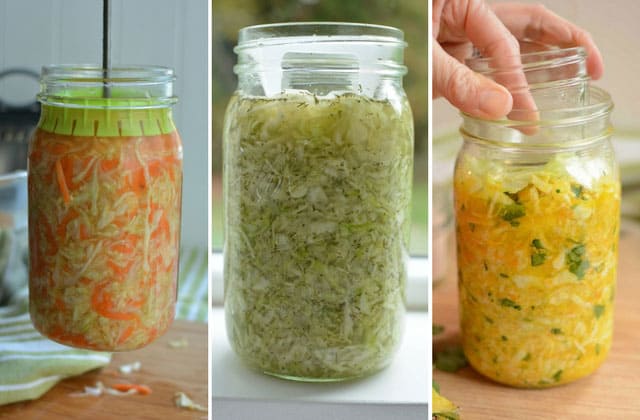
As I expand my fermentation repertoire and also better understand why my ferment might bulge above the brine, I am slowly seeing the benefits of a device that is strong enough to contend with the power of the Mighty Microbes furiously working away in a jar of fermenting sauerkraut. I have used fermentation weights – Pickle Pebbles – but find that every once in a while they are not heavy enough, especially with an extra active batch of sauerkraut.
Enter…
Fermentation Gates!
Fermentation Gates is a term I have coined to describe a device safely locked inside the neck of your jar, that no matter how much force you apply to it – or how much gas is created by the Mighty Microbes – it will not open, or move up the jar. Your ferment does not bulge up and out of the brine.
The silicone Pickle Pusher by the Ultimate Pickle Jar,
the plastic Canning Buddies by ViscoDiss,
the stainless steel Fermentation Lid by KrautSource,
the stainless steel – made in the USA – PickleHelix by Trellis and Co. and
the glass jelly jar I use in my teaching recipe are all examples of Fermentation Gates.
See Can I Use Plastic? Silicone? Stainless Steel? for Fermentation for a discussion on how the various materials perform in the acidic environment of fermentation.
Nothing is foolproof, but I am generally finding that my ferments remain below the brine throughout fermentation when using one of these devices. I have reviewed the first three and have been using the PickleHelix, but have yet to put a review together for it. Please note that the link to the PickleHelix might be just for the lids. Their company just moved manufacturing to the US and I believe they may be struggling to meet current demand.
[su_panel url= “https://www.makesauerkraut.com/pickle-pushing-no-float-jar-packer-review/”]
[su_icon_text color=”#9200ab” icon=”icon: thumbs-o-up” icon_color=”#bed738″ icon_size=”20″ url=”https://www.makesauerkraut.com/pickle-pushing-no-float-jar-packer-review/”]REVIEW POST: Pickle-Pushing No-Float Jar-Packer Review: Ingenious[/su_icon_text]
[/su_panel]
[su_panel url= “https://www.makesauerkraut.com/viscodisc-canning-buddies-review/”]
[su_icon_text color=”#9200ab” icon=”icon: thumbs-o-up” icon_color=”#bed738″ icon_size=”20″ url=”https://www.makesauerkraut.com/viscodisc-canning-buddies-review/”]REVIEW POST: ViscoDisc Canning Buddies REVIEW [Simple & Affordable]
[/su_icon_text]
[/su_panel]
[su_panel url= “https://www.makesauerkraut.com/kraut-source-review/”]
[su_icon_text color=”#9200ab” icon=”icon: thumbs-o-up” icon_color=”#bed738″ icon_size=”20″ url=”https://www.makesauerkraut.com/kraut-source-review/”]REVIEW Post: Kraut Source Fermentation Lid REVIEW [Solid Design][/su_icon_text]
[/su_panel]
T&Co. PickleHelix Fermentation Kit – MADE IN USA!Watch for Mold and Yeast Growth
If conditions for fermentation are ideal, rarely should you see mold or yeast growing in your jar. If you do, use it as feedback to adjust things for your next jar of sauerkraut.
Kahm Yeast
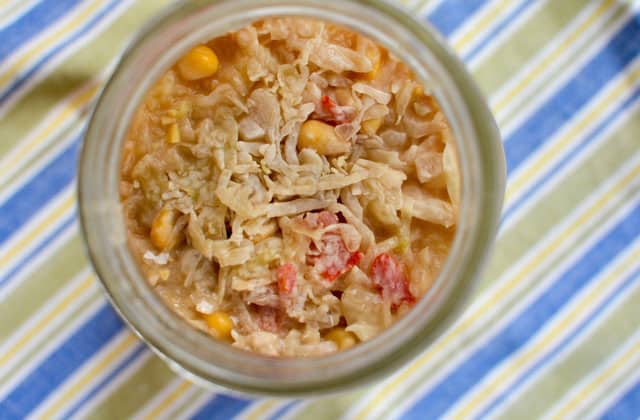
Kahm yeast is a thin, white to cream-colored powder that accumulates on the surface of the brine in your ferment. The powder can also appear as a creamy scum if it forms and then the brine level drops below the surface. It is harmless, appears most often during warm weather and with sweeter vegetables, such as beets and carrots.
In the above picture is Kahm yeast on a batch of sauerkraut containing sweet corn and sweet peppers and fermented during the summer. A bit of a challenge. I removed the top layer of sauerkraut and all underneath was flavorful and quite edible.
Due to its powdery nature, it can be hard to remove, and once it has invaded your jar, it tends to reappear after removal. Therefore, most recommend waiting until fermentation is complete when you can carefully remove all of it and then repack your sauerkraut into a clean jar. For future jars, try a bit more salt or wait to ferment at cooler temperatures.
Fermented Food Lab has a post with some pictures of Kahm yeast. I find it is more common on brined pickles and vegetables than on sauerkraut.
Mold
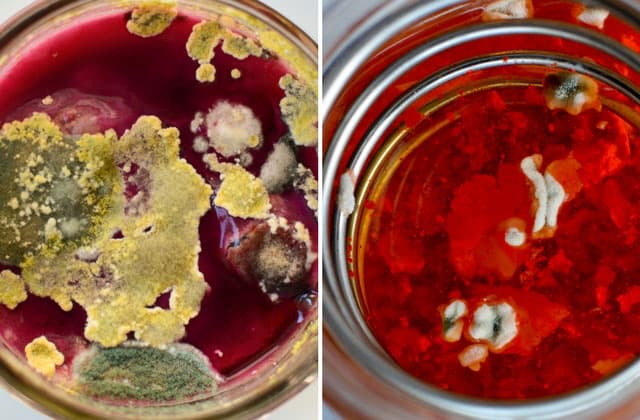
Mold is raised and fuzzy and can be white, black, blue, green or even pink. Mold grows from mold spores that are present everywhere in the air and on the surface of fruits and vegetables. Mold begins growing when spores land – or already exist – on a wet nutrient-rich surface, such as bits of exposed cabbage, and over time grows into a thick layer.
In the image on the left is mold on a neglected batch of fermented beets. It was August and time to leave for a few weeks of vacation. I left my beets to survive on their own in our warm house. This is what I came home to. The unwanted – but beautiful – growth of colorful mold spores.
In the image on the right is the start of mold growth on a batch of fermented red pepper sauce. Peppers are especially prone to mold growth due to their sweetness and fermenting them during the summer.
Fermenters fall into two camps on what to do with mold. The Toss-Your-Ferment Camp believes mold grows invisible tendrils down into your ferment, can never be removed completely and makes the ferment dangerous for consumption.
The Remove-Mold-and-Consume-Your-Ferment Camp believes mold only grows on the surface and can be safely removed. If you fall into this camp – which also includes those of us who have a hard time wasting food – carefully remove the food layer that has the mold and consume the fermented food below, as long as it smells and tastes fine.
The few times I’ve made the decision to toss a jar of moldy sauerkraut, I have removed that top layer of nasty looking stuff to unearth wonderful, tangy and fresh smelling sauerkraut. I then stop myself mid-toss, as my hate-to-waste side kicks in, and save it from the compost pile to then be enjoyed by the family.
I will eventually do an in-depth post on mold, but until then you may find this post at The Fermentation Podcast educational and helpful: Five Questions on Mold and Food Safety.
Check the pH of Your Sauerkraut to Ensure It Has Properly Fermented
- These papers will enable you to detect 0.5 pH unit differences with unprecedented sharpness...
- Hydrion Brilliant pH Paper is a general use pH paper.
- Distinct and easily read color seperations
If you are the over-cautious type, you might want to use pH strips (0.0-6.0 pH range) or a pH meter (I haven’t used a pH meter yet, but am realizing that pH strips won’t work with colored brines, like in a beet sauerkraut.) to check that the acidity of your sauerkraut has reached a “safe” level.
pH is a measure of the acidity and alkalinity of a solution that ranges from 1 to 14, 7 being neutral. The lower numbers indicate acidity, the higher numbers alkalinity. Vinegar and lemon juice read at the acid end; lye and Milk of Magnesia at the alkaline end. The pH of fresh cabbage is around 7.0 and typically drops to about a pH of 3.4 during the fermentation process.
We want the brine in our sauerkraut to read on the low end of the scale – the acid end – aiming for numbers of pH 4.6 and below. Numbers below 4.6 will tell us that acid-loving bacteria are thriving and that pathogenic bacteria, including Salmonella and E. coli have been destroyed. Literally destroyed. Eradicated. Obliterated.
I find this quite incredible.
Just imagine, you could have purchased a head of cabbage – even organic cabbage – that you didn’t know had been sprayed with contaminated water – water containing E. coli bacteria. It’s now packed in your jar and fermenting on your counter. But, have no worries. Guess what?
Our microscopic friends are working away, producing lactic acid to kill off the bad guys, that E. Coli or whatever other gangs of bad guys snuck on. Enter the marvels of nature and the ancient art of fermentation.
This is why many of us in the fermentation community say it’s safer to eat sauerkraut than a fresh spinach salad. Really!
To test the pH of your sauerkraut, wait at least until the end of the first week, then open your jar, remove your weight, peel back the Floaties Trap and push down with a spoon to grab a bit of the brine. Dip a pH strip in the brine in your spoon and read it according to directions on the package. Since pH strips can be slightly inaccurate, your safest option is to consume ferments that give a reading of 4.0 or below.
Trap Any Pesky Fruit flies
If you are fermenting during summer and you notice fruit flies in your kitchen, you may want to set up a trap to prevent them from sneaking into your jar of sauerkraut. Two effective methods I use are:
Add a drop or two of dish soap to a shallow dish and top with cider vinegar. The vinegar attracts the fruit flies and the soap reduces surface tension causing them to drown.
Place apple cores or other fruit bits into a small bowl and tightly cover with plastic wrap. Use a toothpick to poke a set of holes in the plastic. The fruit attracts the flies and they find their way into the bowl through the small holes but they can’t find their way back out.
Evaluate Your Sauerkraut to See If It Has Fermented to Your Liking
Don’t open the jar!
Don’t let any air into your ferment!
Don’t touch it for 21 days!
OR…
Open daily!
Taste and stir regularly!
What’s a newbie to fermentation – or a seasoned expert – to do?
I fall in between the two extremes.
I feel that the most crucial period for you fermenting sauerkraut is the first week. By Day 7 – under ideal conditions – lactic acid levels have reached a high enough concentration to deem your sauerkraut safe from nasty critters, but, not fully fermented.
During the first week, I try not to disturb my sauerkraut. Don’t lose sleep, however, if you feel you need to open your jar to push your ferment below the brine or remove little floating bits. The process is more forgiving than many of us like to admit. Opening your jar – or crock – is not going to ruin your lovely ferment and you will probably find it helpful to start tasting and evaluating at this point.
At the 7-day mark (5-day if fermenting in a warm environment; 10-day if your home is extra cool), open the jar, pull out the small jar or weight, and smell and taste your sauerkraut. It should start to taste sour and no longer taste like salted cabbage. Its colors should be fading and not bright like fresh cabbage. It will have a pleasant vinegar-like smell. Once you’ve dialed in the fermentation for your home environment and time of year, you won’t be opening your jars as often.
Ideally, you would let it ferment for 3-4 weeks. This allows time for each of the three successive colonizations of hard-working bacteria involved in fermentation to perform their magic. However, this is a learning process and for some, a gradual adjustment of taste buds to this newfound food may be necessary. You may decide your jar is done fermenting as early as 7-10 days.
What to look for to deem that a jar has transformed from salty cabbage to sour sauerkraut?
Color
The cabbage and vegetables are no longer bright green but, instead of pale green or even yellow. Strands will also appear somewhat translucent.
Smell
Your jar of sauerkraut should smell sour, reminiscent of vinegar.
Texture
The texture of your sauerkraut can vary from crisp and crunchy to soggy and soft and is dependent upon the amount of salt used, the temperature you are fermenting at and how long you ferment. There is a personal preference here. I like a bit of a crunch; others are looking for a soft texture.
Taste
You are looking for a slightly sour or tangy taste with a “bite” to it… A clean acid flavor… A bit salty but not as salty tasting as when you first packed your jar… A more complex flavor than just the cabbage you packed into the jar…
A depth of flavor that makes you go WOW! This is GOOD!
If your sauerkraut is not quite where you think it should be, think of fine-tuning 3 dials: Salinity, Time and Temperature.
Is Your “Sour” Kraut Not Sour Enough?
The sour flavor in sauerkraut comes from lactic acid produced by the lactic acid bacteria (LAB) eating the sugars in your cabbage and vegetables. Once all the sugars have been converted to lactic acid, your max levels of tang have been reached.
- Time. If the cabbage you used wasn’t especially sweet you may not find your sauerkraut to be sour enough a few weeks into the process. Let it ferment a few days longer, then sample once again.
- Provide more sugar for the LAB. For future batches under similar conditions, experiment with adding a touch of sugar to your ferment, say ½ teaspoon for a 1-quart jar, which will provide more food for the LAB to then create higher levels of lactic acid.
Is Your Sauerkraut Too Soft?
You can’t rescue the current batch but for future batches, adjust one or all the Salinity, Temperature and Time dials.
- Salinity. Bump up your salt numbers just a tad; add ½ teaspoon (4 grams).
- Temperature. Ferment at cooler temperatures.
- Time. Ferment for a shorter time period.
Is Your Sauerkraut Too Crisp and Crunchy?
To achieve a softer texture, adjust one or all the Salinity, Temperature and Time dials.
- Salinity. Use a tad less salt for future batches.
- Temperature. Ferment at warmer temperatures.
- Time. Ferment for a longer time period.
- Pound! When you are making your next batch and once you have mixed in your salt, spend some time actually pounding your cabbage mixture to break down the cabbage more than is possible by just “massaging the salted cabbage mixture with strong hands.”
Is Your Sauerkraut Too Salty?
Personal preference along with the type of salt you used will play a factor in how salty your finished sauerkraut tastes.
- Use a mineral-rich salt. Himalayan Pink Salt was used in all the recipes. Himalayan Pink Salt – and Real Salt – are mineral-rich salts that impart a greater depth of flavor to foods than ordinary table salt does.
- Use a bit less salt. Decrease the percent of salt used down to 1.5%. (2 ½ teaspoons; 12 grams)
- Add a potato slice. I have not tried this, but culinary experts often add a raw potato slice to dishes that are too salty. In theory, it will act like a sponge, absorbing the excess salt.
- Rinse. Just before eating, you can give your sauerkraut a quick rinse. This will wash off some but not all of the beneficial bacteria.
- Disperse the saltiness. Mix your sauerkraut into a salad or stir into a dish just before serving.
Store Your Sauerkraut
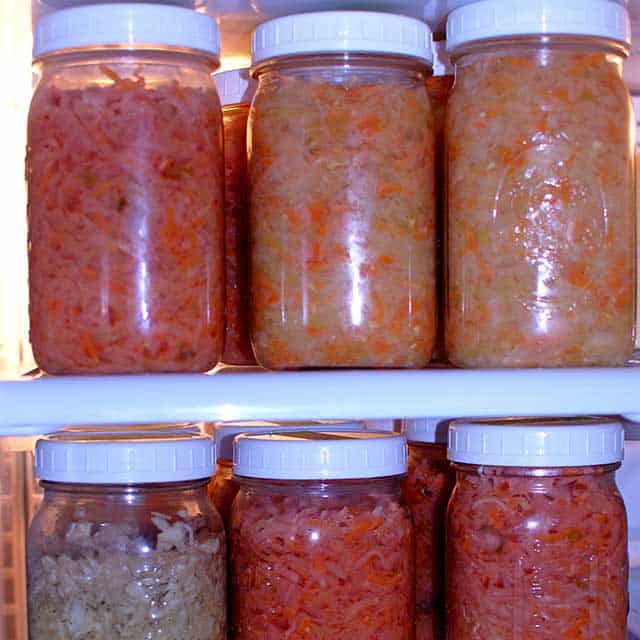
Once your sauerkraut has fermented to your liking, it is time to move it to “cold” storage. For most, this is your refrigerator. Here are some other options. Do realize, however, that your jar of sauerkraut can also be left out at room temperature. It is preserved! However, it will continue to shift in flavor and soften in texture.
Ready Jar for Storage
Remove the weight you used, cleaning it and leaving it available for use in other jars. Wipe down the rim of the jar and clean off any stickiness on the outside of the jar. I leave in my Floaties Trap until I’m ready to eat the sauerkraut. Clean lid and screw back onto the jar.
Enjoy for a Year
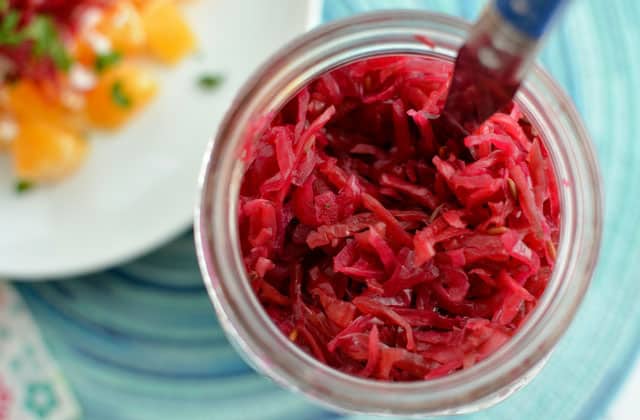
A typical refrigerator is set at 35° F (1.6° C). Properly fermented sauerkraut stored at this temperature can keep for a year without much change in texture. The flavor will continue to shift and age much like a fine wine. The coolest spot in a refrigerator is at the back of the lower shelves.
Extra Brine?
If you find leftover brine when you get to the bottom of your jar, don’t toss it! The brine full of the same probiotic goodness as is with sauerkraut. Drink it. Use it in a salad dressing. Or, use it to top off a dry jar of sauerkraut that has finished fermenting.
Use this set of fermentation signs to monitor, tweak and enjoy your jar of sauerkraut as it ferments in your home. What do you like to watch?
Sources:
Fermented Fruits and Vegetables: A Global Perspective

Last update on 2024-07-26 / Affiliate links / Images from Amazon Product Advertising API

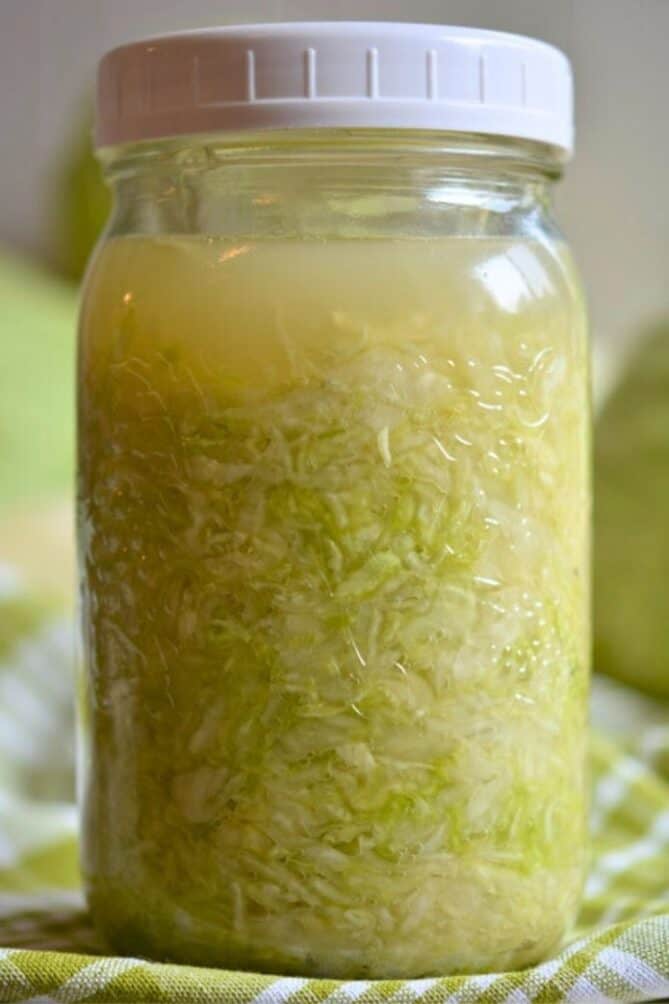

 This post may contain affiliate links which won’t change your price but will share some commission.
This post may contain affiliate links which won’t change your price but will share some commission.